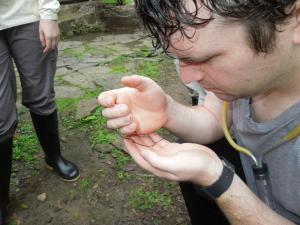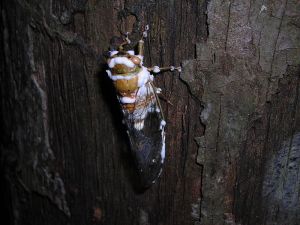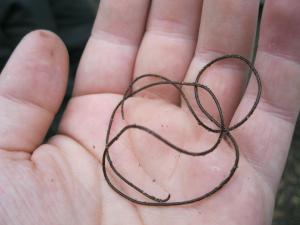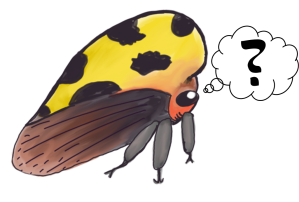Written by Joe Ballenger
@BugQuestions what kind of parasites do mantids have? Is there a link with lots of photos?
— Sarah Herlong (@HerlongSarah) February 6, 2015
Everybody loves mantids. In fact, of all the questions we’ve gotten here on Ask an Entomologist, mantids are the insects everyone asks about. So it makes sense to dedicate an entire month to these big, beautiful bugs.
I’ve made it no secret that I love parasites, because they do some crazy cool things. So I was estatic when someone asked about mantis parasites, because I get to marry my favorite subject-parasites-with the obvious favorite insect of our readers.
As far as insects go, mantids are the apex predator because there’s not much that can mess with a full grown mantis. In fact I only know of one species of wasp, Stizus ruficornis, which specializes on mantids. Most other members of this genus prey on grasshoppers, which live in the same habitat.
Other than that, the only things which mess with adult mantids are vertebrates like bats and birds.
When you’re near the top of the food chain, you’re probably not afraid of predators. Instead, the things which are going to bring you down are much smaller than you. If you’re big, you’re more afraid of getting sick than getting eaten. This is why I think parasites are so cool: their whole thing is bringing larger animals down.
Mantids get a wide range of parasites, some of which are quite unusual. They’re attacked by wasps, flies, beetles, fungi and worms called Nematomorphs. It’s worth mentioning that a lot of these are very poorly known, and some of these have only been sussed out in the last few years. This means that some questions, like whether they’re host specific, might not have answers.
So…let’s talk mantis parasites!
Wasps
Virtually every insect has parasitoids, and most people are familiar with those that feed inside the insect larva. Parasitoids also feed on eggs, as well. The wasps which parasitize mantis eggs are an interesting group, because of their habits and relationships.
Mantidophaga
In terms of habits, I’m quite fond of the Scelionid wasp Mantidophaga. This wasp is a tiny wasp which feeds on mantis egg cases as larvae. This is a pretty standard lifecycle, but the cool part is how it gets to those egg cases in the first place. Mantidophaga is a parasite in both it’s adult and larval stages. The larvae live inside mantis egg cases, but the adult lives on the mantis itself in groups as high as 5. After it hatches from the egg case, it flies to find a new host.
Instead of looking for an egg case, however, the wasp lands on an adult mantis. She then promptly tears her wings off, because she’s never going to leave her host. It doesn’t matter whether it lands on a male or female, because it can just jump ship during mating. Instead, it lives on the wings of the mantis and drinks it’s blood while waiting for the mantis to lay her eggs.
Podagrion

This is a Podagrion wasp, which is a beautiful emerald green with ruby red eyes.
Picture credit: Edward Trammel, used under Creative Commons License from Bugguide.net
Not all mantid parasitoids are hitch-hikers. Scelionid wasps are famous for this habit, but there are others which don’t have this habit. The Torymid wasp Podagrion parasitizes mantis egg cases, and uses largely visual cues. The interesting thing about Torymidae is that they’re specialists of gall wasps and usually prey on the wasps which create them. Because mantis egg cases look like galls, this sort of specialization gives a clear evolutionary pathway to this group’s specialization.
Even though I find the lifestyle of Mantidophaga more interesting, I love the Torymids. Torymid wasps are, in my opinion, the most beautiful of insects. They have a magnificent coloration-emerald green with ruby red eyes-they look like living jewels.
Nature1upclose has some rather amazing videos of insects in general, but they have a particularly amazing video of Podagrion emergence.
This video narrated by David Attenborough features a more typical member of this genus, which parasitizes insects which live in galls.
Flies
Flies of at least two families attack mantids, Sarcophagidae and Tachinidae. Most Sarcophagids are known for living on rotting flesh, but there are a lot of species which attack insects-particularly grasshoppers. Unfortunately, other than knowing they exist, I’m not at all familiar with the Sarcophagid mantis parasitoids.
I am, however, familiar with the Tachinid mantis parasitoids.
Well, the Tachinid mantis parasitoid. Masiphya is a fly that attacks mantids (specifically the Carolina mantis), and whose larvae have been reared out of mantids. This animal isn’t much bigger than a housefly, which means that the mighty mantis can be brought down by an animal smaller than the size of the insects it usually eats!

This is very likely a parasitized mantis. The discoloration and discharge from the top of the abdomen is typical in insects after the emergence of Tachinid larvae.
She is very lucky, having reached adulthood. This happens in very lucky individuals, but is very rare.
Photo credit: Greg Lasley. Photo used under a Creative Commons Liscense from www.bugguide.net.
There’s not a lot that’s known about it, other than it’s basic lifecycle. The mother injects an egg into the mantis, right near the grabby legs. The larva then travels through the body, and settles in the abdomen after building a respiratory funnel. So far as I can tell, the maggot drinks the mantis’s blood, and then burrows out to spend some time as a pupa in dirt.
The interesting thing is that parasitized mantises are easy to spot. Late in the year, between August and October, adult mantids will be common. You’ll know the adults because they’ll be a few inches long, and will have wings.
If you’re lucky enough to find a bunch of mantids you might notice some which don’t have wings and which are only about half the size of the adults. These are the mantises which have been parasitized. The flies remove so much blood that the mantises never grow up to be adults, although they survive their ordeal.
Interestingly, while looking for pictures to put in this article I found a specimen (pictured above) which looks like it reached adulthood after parasitism. It’s rare, but does happen.
You can find a picture of the fly here. The picture is copyrighted, and I was unable to contact the photographer for permission to use in this article.
Nematomorphs
There are some mantis parasites which aren’t insects, but which definitely interest people. On Twitter, people are constantly posting videos which show huge worms coming out of various mantids. Unfortunately, most people focus more on the horror of the parasite instead of talking about the life cycle. While I love parasites, these sorts of videos make me sad because these parasites are fascinating.
Most of these videos feature a relatively obscure group of parasites called Nematomorphs, which are different than nematodes or earthworms* which are more familiar to many people. Nematomorphs are really cool because they use at least two hosts, and have to travel between completely different environments to complete their lifecycle. Life for a Nematomorph host is extremely brutal, because one host must get eaten while the other must drown.
What you see above is the back-end of the lifecycle, where the adult takes over the mind of her host and forces it to drown in a body of water. The adult is free-living, and lives in a pond or river. The adult doesn’t eat, because it doesn’t have a digestive tract. Or a circulatory system. Or a respiratory system. It’s basically a swimming reproductive system, and females may lay over one million eggs in her lifetime.
These eggs hatch, and there’s a short-lived larval form which finds an aquatic insect, like a mosquito. The Nematomorph then hangs tight while the insect does it’s thing and turns into an adult. After the insect leaves the water, like mosquitoes do, it needs to get eaten by the host the adult develops in. After getting eaten, the parasite migrates to the abdomen of the second host and begins absorbing nutrients through it’s skin until it’s time to hijack the host and emerge.

Joe contemplates a Nematomorph he captured during a trip to Ecuador. The animal was released unharmed back into a nearby stream.
So to recap, Nematomorphs are incredible. They’re only parasitic as babies, but to grow to an adult they need to find an insect which will leave the water. That first host needs to be eaten by the second, and that second host needs to drown with ‘help’ from the Nematomorph. They also have to survive two different immune systems, which is an accomplishment in and of itself.
Fungus
Beauveria
Parasitic fungus is something which captures the imagination of lots of people, and the genus Cordyceps was made famous by David Attenborough. It’s not hard to understand why, because it exhibits mind control properties and almost always has bizzarre fruiting bodies.

Cicada infected with Beauveria fungus in Bolivia.
Image credit: “Beauveria bassiana 16552” by Danny Newman (newmy51) at Mushroom Observer. Licensed under CC BY-SA 3.0 via Wikimedia Commons
Most parasitic fungi aren’t as elegant as Cordyceps, though. The most common fungus which attacks mantids is a fungus called Beauveria, which seems to be a strain of sexless Cordyceps. Beauveria is kind of the model insect-killing fungus. It’s easy to culture, infects a wide range of insects, and can even be used as a biological insecticide.
Beauveria kills the insect, and then uses the body as a medium for growth. It doesn’t really have any need for mind-control, and insects just kind of grip onto whatever they’re standing on when they die. Insects infected with Beauveria don’t get fruiting bodies like those infected with Cordyceps. Instead, they just turn fuzzy and white.
Bottom Line
Mantises do get a lot of parasites, most of which have their own bizzarre and interesting lifecycles. Many are extremely beautiful, or just have mind-boggling complicated lifecycles. There are also some insects, mainly beetles and flies, which use mantis egg cases for food.
*I’ve got a friend who will get really mad at me if I don’t mention that one family of nematodes, the Mermithids, have independently evolved a lifestyle which is almost identical to Nematomorphs. If anyone’s interested, I can tell you how to tell them apart from videos.
Sources cited:
-
Clausen, C. 1940. Entomophagous Insects. McGraw-Hill. York, PA. 688 pp.
-
Luan F, Zhang S, Cai Y, Sun Z, Wang B, Huang B, Li Z. 2011. Identification of the molecular origin and and development of a panzootic caused by Beauveria bassiana in praying mantis populations in eastern China. Journal of Invertebrate Pathology 108(2): 98-105
-
Pechenik, J. 2010. Biology of the Invertebrates, 6th edition. McGraw-Hill. Boston, MA. p. 452-457.
-
Young OP. 2009. Parasitism of Stagomantis carolina by Masiphya confusa. Annals of the Entomological Society of America 102(5): 842-846



Pingback: Why do insects lay their eggs in patterns? | Ask an Entomologist
How nice to find this article, since I can’t seem to find anything else about mantis parasites. This morning I collected a dead mantis (presume Carolina mantis) from my porch screen and brought it in so I could look at it. I put it in a little dish and almost immediately, larvae began to emerge from the abdomen, from under the wings, and from between other body parts. The larvae are about the size of house fly maggots, but smoother and more pointed at each end. Each larva has a black spot inside of it near one end. I watched for quite a while and 18 larvae emerged in total. (It was a little spooky because the larvae were making the mantid’s legs and wings move as they emerged!) So from reading your article, I’m guessing that these might be the Masiphya (Tachinid fly)…altho with further reading, it looks like that parasitoid doesn’t kill the host? So perhaps these were larvae of a Sarcophagidae? I let them all go, of course. 🙂
LikeLike
Susan,
Unfortunately it’s hard to tell if something’s parasitic if it’s found in a specimen that’s already dead. If I were forced to guess, I would guess these are phorid fly larvae. Specifically, one of the flies in the genus Megaselia.
Megaselia scalaris is pretty good at colonizing things pretty fast, within minutes of death, so some entomologists have confused it for a parasitoid. However, it needs the host to be dead before it starts feeding.
This sounds more like a coffin fly than a parasitoid, but an adult would be needed for an ID.
LikeLike
Thanks! It was very much as if the dead mantis was a sarcophagus. I didn’t save/hatch the larvae…maybe next time! 🙂
LikeLike
Does every mantis have parasites?
LikeLike
Here’s an interesting related article:
Click to access first-record-of-Megaselia-scalaris.pdf
LikeLike
Our mantis died a slow protracted death. afterwards I found her abdomen to be completely full of vthese horrible white small things. About the size of grains of rice. I don’t know if eggs or larva. I took photos. I’d really like to know what happened to her and what they were.
LikeLike
Yes please answer this! My mantis had the same thing happen. I thought it was a horsehair worm until all of these tiny maggot things came out! It was an awful thing to witness and I haven’t found any answers as to what they are!
LikeLike
To me, this sounds like a fly infestation.
Horsehair worms are much larger, and take over the abdomen of the whole insect. Usually, there’s only one per host.
LikeLike
Lindsey and Pauline: Did you read the comments from the entomologist in answer to my original question? He names several different types of flies that it could be.
LikeLike
we have an interesting ordeal going on..we found a male on our curtain and the back end looks like its trying to lay eggs but its a male and when the light hits that section it spasams where the rest of the mantis doesn react to the light at all. do we have a parasitic worm?
LikeLike
I’m not really sure. The only way we can know that is to dissect the critter in question, or hold the abdomen of the mantis underwater.
It’s possible that there’s a worm in there, but it could also be a case of pesticide poisoning.
LikeLike
I have an adult mantis on my window screen as we speak with something looking like that fly emerging from it’s abdomen
LikeLike
You might have an error in names. The sources I looked at listed Mantidophaga as a Tachinid fly and Mantibara as a Scelionid attacking mantises.
LikeLike
My mantis is currently having maggot like worms emerge from her abdomen. My guess is she is infected a fly parasite. It is very hard to watch her go through this and I really want to know if she will survive? The maggot like worms come out of her abdomen and immediately burrow. Habdomen is swollen and
LikeLike
Found this many is in my back yard. Very much alive. Thought it had eaten something. Turns out it was filled with larva. Took pictures but can’t insert them.
LikeLike
Mantis
LikeLike